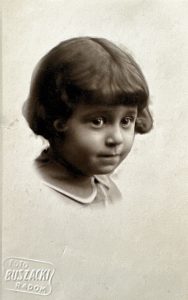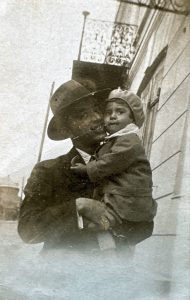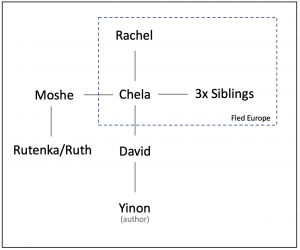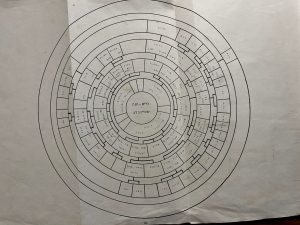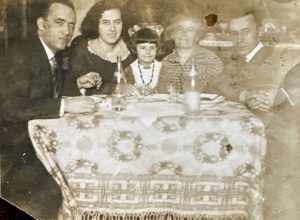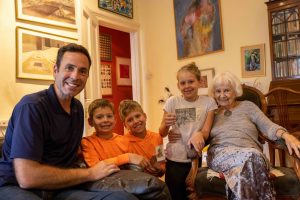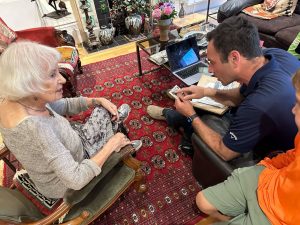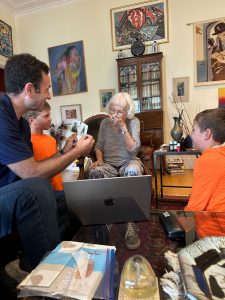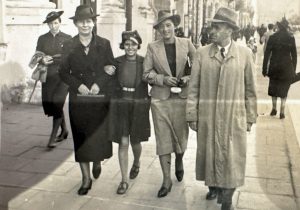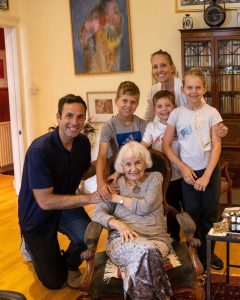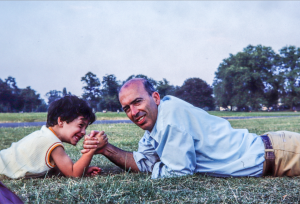How 90-Year-Old Photos Shed Light on a Dark Past and Reunited a Family
By Yinon Weiss
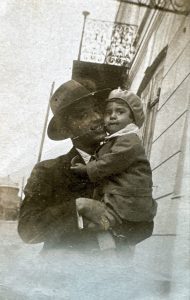
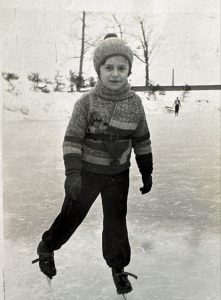
Photos 1 and 2: Two of the photographs I discovered. They lacked context and explanation.
In the quiet corners of family albums, photographs often hold secrets, waiting to be uncovered. For me, it was a set of nearly century old photos of a young girl tucked away in the dusty pockets of my father’s home that set me on an extraordinary journey halfway around the world. The seemingly ordinary images, preserved across three generations, held the key to a family connection long forgotten. My quest to uncover their story shed light on my family’s difficult past, and led to the reunion of an orphaned relative separated from us since WW2.
Unexpected Loss
I grew up without much family, but we were a happy small group. With my brother eight years older, in many ways I felt like an only child. Both my parents were single children and I was raised with no grandparents, uncles, aunts, or cousins. We had no holiday gatherings, no family reunions, and no family visitors. I accepted it for what it was. I later married into a wonderful and large family and now have three children of my own. My father and I grew particularly close after he became a grandfather and that served as my family foundation.
My sense of stability shattered when my father suddenly died. With my mother gone, his passing represented the end of an entire generation. I was devastated. Thoughts of him filled me with tears, the kind I’d only seen my own father shed once before, when he buried mother. Between our two adult lives, I’m unable to recall a time I’d last wept. While I knew I shouldn’t, I hid the extent of my grief from others.
My wife helped me muster the courage to go to his home, where I was raised, to collect all his documents tucked away in dusty boxes. I began to dig into his roots as a way to deal with the grief and to find answers. I converted part of our home into an archiving and analysis room where I spent mornings and evenings processing through another batch of photos. I always completed this ritual with the door closed, should a new found memory of my parents trigger an overwhelming emotion.
Photos from the Past
Among the documents I found numerous pre-WWII photographs of our family in Europe, including several of a young girl that my father never mentioned and later I understood why; he simply inherited the photos from his own mother and held on to them. These photos would lead me on a quest to learn of their origin and meaning, providing insight into my family’s difficult past and ultimately to a shocking discovery.
Much of my family history is interconnected with the Holocaust and the long shadow it has cast, starting with my grandparents who fled Europe leaving everything including some family behind. My father, David Weiss, was born in the middle of this chaos in what would become Israel in the spring of 1943. Due to global instability, both my paternal and maternal grandparents opted to have only one child. My father later recalled the bombings he observed around him as a five year old boy in Israel’s War of Independence, and like most Israelis of his generation, he would go on and fight in multiple wars defending the nascent and vulnerable Jewish state. In his mid-life working as a civilian he moved our young family to Silicon Valley in the United States in hopes of pursuing greater opportunities and stability for his children, just as his parents’ generation did. He became a US citizen and imagined his children would avoid fighting in the Middle East as he did, later recognizing the irony in my decision to join the US military and serve in the Middle East, just as he did. The apple never falls far from the tree, as he would say.
My father accomplished many great things professionally as an award winning engineer and helped provide us with a great education. Yet, he never spoke of our painful family past and shared very little about our extended family. Outside my parents and brother, I’ve only seen another family member once in the last 30 years; a Holocaust survivor from my paternal grandfather’s side who died a few short years later. This was at my mother’s funeral 15 years ago. There was nobody from my mother’s side in attendance.
I was fascinated by the pre-war photos I discovered at my father’s home because they told a different and much larger family story than what I’d known. I was drawn to learn more about my family history but faced an obstacle in that I now had no living relatives to turn to and ask questions. When we moved to the United States in the 1980s, we lost contact even with our distant Israeli relatives.
Tracing Forgotten Footsteps
It was hard to know where to start. There was no written or oral history of my family’s time in Europe, but something drew me to focus on the girl and her photos as a key piece to solve. The first clue I had was what appeared like a child’s handwriting on the back of two photographs, written in Polish, signed “Rutenka”, and dated May 11, 1934. I therefore had a time period, a likely country, a possible first name, but not much else. I consolidated her pictures in an envelope labeled “unnamed girl.”
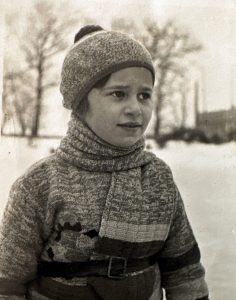
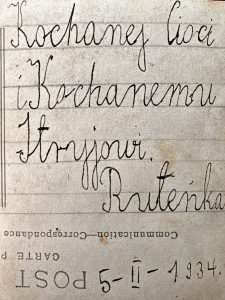
Photos 4 front and back: Rutenka’s writing
I hired two genealogists in Poland who specialize in Jewish history, Marta Mackowiak and Daniel Paczkowski, though the two didn’t know I was working with each separately. I also hired genealogist Rose Lerer Cohen in Israel, and Baruch Adalbert in Ukraine. With the information I was able to provide, they delivered birth and death records going back as far as the mid-19th century, which when combined with an incomplete family tree my father left me 20 years ago, Yad Vashem testimonial pages, online DNA databases, and old fashion detective work, I was able to identify many previously unknown past family members and even a few distant cousins. It became a real-life puzzle to solve, with each piece of the puzzle unlocking clues to the next. Each living distant relative I would find I would ask to interview over the phone. Some were happy to share long ago forgotten family stories, while some would not return my call. Whenever I did learn about somebody’s ancestors, I would add their information as new pieces to the tree, yet none of them could explain who Rutenka was.
Across both my parents’ families, I tragically identified over 50 extended family members murdered in the Holocaust.
I began to form a theory on Rutenka’s identity. First, Rutenka’s photographs were found among pictures of my father’s mother, and so I knew she must be related to the family through her. In the group photo (Photo #5), she is also seen sitting next to who I came to believe was my young grandmother, although I couldn’t be sure and I couldn’t identify anyone else.
Photo 5: One of the photographs I found among my father’s collections without context. Initially I only recognized my grandmother as the woman on the left.
Focusing on my paternal grandmother, Chela Weiss (née Weissberg), I knew from my father’s family tree that she and three siblings emigrated to Palestine from Eastern Europe before the war, but that the oldest brother stayed behind. My father’s family tree simply listed him as “Firstborn – Died in Holocaust” with no additional information. It seemed his mother didn’t speak about it much either.
I had always assumed family records were destroyed in WWII and it would be hopeless, but that was not the case. I was able to get a copy of the January 1900 birth record of Chela’s oldest sibling, and I now had a name, Moshe Weissberg. I suspected Moshe was the unidentified man in multiple photos with my grandmother, which was the second big clue. He was also clearly connected with the girl, and so I came to believe the girl in the photos must be his daughter, although my father’s family tree had no mention of a child. Through Yad Vashem testimonial pages, I also found the name of Moshe’s wife, Anna Weissberg (née Noifeld). I started to form a narrative that perhaps he was the only sibling to remain in Europe because he was the only one rooted with a family.
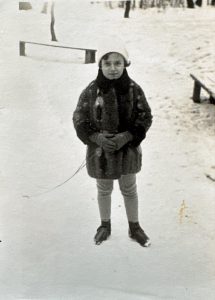
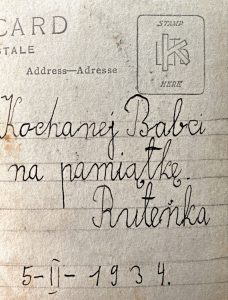
Photo 7 and back of another photo: Ruth’s from 1934, in which she signed the back as a memento to her grandmother, my great-grandmother.
More clues emerged as I kept investigating. One of my Polish friends helped translate the writing on the back of two photos, which read “To my dear grandmother” and “To my dear aunt” signed by Rutenka. This supported my hypothesis that Moshe had a daughter named Rutenka, including the fact that Moshe’s mother, Rachel Weissberg (née Steinberg), my paternal great-grandmother, also emigrated to Palestine, and so would have received the card addressed “To my dear grandmother” from Moshe’s hypothesized daughter, Rutenka. This would make me the fourth generation to receive this photograph. It was a loose theory, and I sought a way to validate it.
I determined that Rutenka’s father, Moshe, was among the Jews in the ghetto of Radom, Poland, set up by the Nazis in 1941. In August 1942, he was among the tens of thousands sent to their death. With few survivors, it was reasonable to assume his family was killed.
While still processing my own father’s death, I planned a trip to Israel. I wanted to better understand his life, my family’s background, and teach my children Jewish history. With months of preparation in my makeshift research room, we identified several second and even third cousins in Israel. Going off only a mailing address, I sent one of them a snail mail introduction and was exhilarated to get a response that eventually led me to a beach in Netanya with Sagiv, a second cousin I didn’t know existed. It was exhilarating to meet a family member of any kind in person. I asked Sagiv about Rutenka and he said he didn’t recognize the name. I pressed for more information about the family and he said “sadly there is nobody left of that generation to answer such questions.” Almost as a consolation prize, he shared that his late father helped him build a radial family tree several decades ago for a school project and that he would share that with me.
The Discovery
A week later I received a digital copy of this old family tree and studied each of its details like it was the world’s most valuable treasure map. It served to confirm many of my findings and filled in key gaps in my own family tree.
Diagram 2: The circular family tree shared with me by my second cousin in Israel.
Within this family tree I found Moshe, my grandmother’s brother, and his daughter Ruth (Rutenka), exactly where I expected them, therefore confirming my hypothesis. This is where the shocking discoveries accelerated. Ruth was listed as married to Michael Posner and that they had a son named Jeremy! My head was spinning, as it implied that Ruth survived the war and even had descendants. It would have taken a miracle for a little girl to survive the Radom ghetto. This would be only the first of a string of incredible events.
To try to find more information, I searched through multiple genealogical records for Ruth, her husband, and son, and came up with nothing. Frustrated and losing hope, I eventually just googled “Ruth Posner” and as destiny would have it, the first listing was a Ruth Posner Wikipedia page. “No, it couldn’t be that easy” I thought. Not everything lined up perfectly such as some of the dates and locations, but as I breathtakingly read the article, I realized that Ruth was very likely one and the same as Rutenka, the girl in the picture. She was my father’s first cousin! Most incredibly of all, the article implied Ruth was still alive at 94 years old.
Photo 8: One of the photos I would bring to Ruth from my father’s collection. Ruth is in the middle. On the far left is Ruth’s father, Moshe. Next to Ruth are my grandmother, Chela, and great-grandmother, Rachel, and on the far right is my grandmother’s and Moshe’s brother Avraham Weissberg (one of the four siblings that fled Poland). I suspect this may have been a final dinner before the family parted ways to emigrate to Palestine, with Moshe and Ruth staying in Poland.
My heart raced with this discovery. I dove headfirst into intense online forensic work for anything I could find about Ruth. I found articles, interviews, and even a book which provided insight into her incredible life.
Rutenka’s Legacy
After the ghetto was created, Ruth’s father Moshe managed to get her employed at a factory making leather goods for the Germans, where the working conditions were harsh. When she left for the factory she said goodbye to her parents, unknowingly, for the last time. Ruth survived the war first by escaping with her mother’s sister, Lola, shedding her yellow Jewish star as she walked across a street guarded by German soldiers and risking certain death if seen. She was 12 years old. Ruth was then transported to a series of safe houses arranged for by her father and aunt, where she was harbored for several years under a Catholic identity and false passport. Her parents were supposed to follow sometime later but never did. Ruth’s family was killed in 1942, and her aunt Lola’s husband and children were executed when they were found hiding in a similar safe house. Ruth lived with both the guilt of surviving, and constant fear of being discovered.
Ruth was still in hiding in 1944 when the Warsaw Uprising took place. After a brutal suppression, the Nazis inflicted severe reprisals in Poland, executing many and taking civilians back to Germany as prisoners of war to work in labor camps. Ruth, who supported the uprising, was still hiding under the identity of a Polish Catholic. She got swept up in this reprisal and taken as a prisoner of war to Germany as a 15 year old girl.
Germans realized the war was likely lost by 1945 and sought to destroy what they could not have. Ruth and the prisoners of war were transported on a train away from approaching Allies, presumably to their demise. Her train came under attack by Allied air forces near Essen, Germany, mistaking her train as a military target. Many passengers died, and Ruth recalls her survival aided by a dead woman landing on top of her. A hand grabbed her and somebody told her to run.
In her final escape, Ruth found refuge in a German farmhouse that eventually fell under British administration in post-war Germany. This is when and where she met British Royal Air Force (RAF) Commander Sidney Scott, a Jewish officer providing refuge to survivors. For the first time in years, Ruth disclosed her secret Jewish identity, and Commander Scott arranged passage for her on an orphan refugee ship to England where she began school again. Eventually Ruth would marry Michael Posner in 1950. She went on to become an accomplished dancer and actress, and later in life an advocate against anti-semitism. In 2022, she received the British Empire Medal for services to Holocaust education and awareness.
A Family Reconnected
Having learned of this remarkable story of survival, I had to find a way to get a hold of Ruth to confirm the connection and meet. I sourced an old address for her in London through Yad Vashem, reached out to the Holocaust Education Trust in London, and messaged my network of friends asking who can get a physical message to her as quickly as possible. Given her place in life, I felt an incredible sense of urgency. Within 36 hours I got a letter in front of Ruth with photographs of her family that she had never seen before. By that afternoon we were on the phone.
In our brief call, we confirmed she was Moshe’s daughter and based on the photos also a family member. She didn’t understand the relationship but was ecstatic to learn of our family. Her husband of 73 years was alive and the two lived in London. I felt an incredible draw to go see her. She said “I’m 94, make it sooner rather than later.” We were still in the middle of our trip to Israel but bought tickets that day.
It was important for me to present Ruth with the physical childhood and family photos that my family had held on to for 90 years. If I could deliver them to Ruth, I felt I was somehow completing a mission on behalf of my father.
There were 9 photos in total, most of which Ruth had never seen, including two photos that Ruth personally wrote on as a five year old, and a photo of her father holding a very young Ruth; the only photo we had of him smiling. At the time, we were still transient tourists in Israel and I was warned about Israel’s postal service. So I asked a friend who runs a business in Israel if his company could receive our incredibly important package and he said yes. I then contacted my neighbors in the United States and guided them to the envelope I originally labeled “unnamed girl” in my research room. Our neighbors carefully packaged all photographs and shipped them to Israel so I could hand deliver them.
After our flight, several trains, and metro rides, we found ourselves at Ruth’s London building. She and her husband welcomed us like old friends, and we had a magical four hours together. For heartbreaking reasons, we learned that Ruth has no surviving children or immediate family outside her husband. We were two people void of ancestral family, now reunited.
My kids and I presented Ruth her photos as a child with her family. Her photo of her father holding her is the only photo either one of us had of her father smiling.
My children heard Ruth’s story firsthand; a story she’d recounted to countless other school children but never directly to her own family. Ruth showed us original photos of Roma and Alexander, Lola’s 6 and 8 year old children, who along with their father, were executed by the Nazis when their safe house was compromised. These were the same physical photos that Lola clung to on her chest over 50 years later on her deathbed. Lola would not have any more children and Ruth inherited the photos.
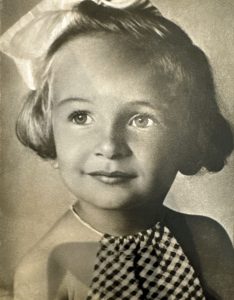
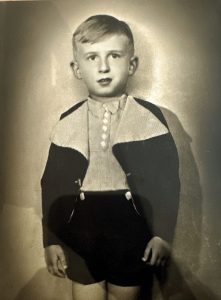
Photos 9 and 10: Roma and Alexander, Ruth’s cousins who also escaped from the Ghetto but were executed when their safe house was discovered.
Ruth and I discussing and sharing notes of common family members from her photo album.
I shared the back of Ruth’s childhood photos, which Ruth wrote by hand nearly 90 years ago.
I also found confirmation that our family in Palestine continued to work to try to get Moshe and Ruth out of Europe throughout the 1930s, sending travel documents and encouraging them to leave. This came to life when I discovered a picture (photo 11) in Ruth’s album, where 10-year old Ruth is seen walking with her parents in 1939. I immediately identified my grandmother’s sister, Regina (Ryvka), hand in hand with Ruth. This revealed that our family visited Poland from Palestine as late as May 1939 encouraging Ruth’s family to flee. However, Ruth’s father was a civil servant and a highly respected and integrated member of society, and like most Jews in Europe, he could not imagine the unprecedented evils that society around him would turn to. Less than five months after the photograph was likely taken, the Germans invaded and escape became impossible.
Photo 11: My grandmother’s sister, Regina Steinberg (née Weissberg and husband Joseph visited Poland in 1939 to try to convince Ruth’s family to leave Europe. From the far left to right; Ruth’s mother Anna, Ruth, Regina, and father Moshe in the streets presumably of Radom. The Germans invaded 5 months later.
Memories and Reflections
Looking back to when I first discovered Ruth’s photos, I sought to uncover their mystery out of a sense of curiosity and void. I never expected they would land me in London meeting a holocaust survivor. With Ruth having no surviving children or family connections of her own, our meeting is more than just a reunion of distant family, we are now among each other’s nearest living relatives.
In meeting Ruth, I was gently reminded that as small as my family is, that there are always others in the world with less. It also showed me that family connections, once lost, can still be rekindled. And most of all, it reminded me that even if we live in a busy world that continuously distracts us, there may be nothing stronger than our innate desire to be with, and be loved by, our own family.
In Ruth’s book, “Bits and Pieces of My Life” she writes “All my life I have been yearning for the unconditional love which one can only find in a normal family. Having lost my son… left me completely bereft, increasing the sense of emptiness.” I’m happy to share that now Ruth does have a family again. She will get regular updates of my kids; events like the first day of school, birthdays, and holiday celebrations. All normal things that people may take for granted with their own extended family, but for both Ruth and I, these will be new family experiences.
“Never forget that the Holocaust can happen anywhere” are the unforgettable words my father told me. The lessons of the Holocaust must be preserved and passed on from each generation to be guarded by the next. My three young children will do more than hopefully fill some of the family void for Ruth. They will also ensure that Ruth’s story, her parents Moshe and Anna, her cousins Roma and Alexander, and the over 50 other family members who perished in the Holocaust will not be forgotten.
Photo 12: The Weiss family; Ruth’s new family
In Memory of my father, David Weiss
1943 – 2022
About the Author: Yinon Weiss is a US miliary veteran and serial entrepreneur.

